Using Endoscopy To Address Foreign Bodies In Pets
Emergency & Critical Care

PATIENT SUCCESS STORY: ETHEL
BACKGROUND
Ethel is a 12-year-old Scottish terrier, who came to Virginia Veterinary Centers (VVC) Fredericksburg location for vomiting and shortness of breath. Ethel was seen by our Emergency department and transferred to the Critical Care department for an endoscopy.
Upon completing an in-house chest x-ray, our team discovered that Ethel had a foreign object lodged in her esophagus. Ethel’s owner suspected that the object could be a “yak cheese” dog chew. Yak cheese is a tasty, protein-filled chew for dogs. However, just like all bones and chews, yak cheese can become dangerous if a large piece is swallowed. Even with constant supervision, accidents can happen. We always encourage pet owners to follow best practices when giving their pets treats and recommend they seek immediate veterinary attention if an accident does occur.
WHAT IS ENDOSCOPY?
There are a few methods for removing foreign objects that have been swallowed by pets. These options include inducing vomiting, extracting the foreign body through the mouth using an endoscope, removing the foreign body surgically, or waiting to see if the object will pass naturally through the patient’s stomach and intestines. Endoscopy is a minimally invasive option that is generally faster than surgery and does not require post-surgical healing.
There are endoscopy tools that may be used to biopsy tissue or grasp and retrieve foreign material. However, these tools must be small enough to fit down a very small channel next to the camera which allows our team to see the patient’s esophagus or stomach and the foreign object. Because these tools are small, not all objects qualify for endoscopic removal.
ETHEL’S ENDOSCOPY PROCEDURE
Our team made several attempts to remove the yak cheese, as well as to try and push it further into the stomach where it could be digested naturally. The cheese was too crumbly to grasp and pull out with the endoscopy tools. The size of the cheese was too big to budge with the scope alone and orogastric tubing (plastic hollow tubing that goes from the mouth down into the stomach via the esophagus) kept deflecting under the cheese instead of pushing it down the esophagus.
Our next attempt involved passing a sterile device (normally used for urinary catheterization) down the esophagus. The device has an inflatable balloon at the end of it. Using X-rays, we were able to wiggle it past the cheese, inflate the balloon, and then slowly retract the catheter in the hope that the balloon would catch on the cheese and help pull it out. Despite successfully passing it past the cheese every time, the balloon was just too soft to move the very lodged cheese.
Safe to say, we were all very frustrated and worried for Ethel that endoscopy was not going to be a successful option. After evaluating why previous attempts failed and discussing our resources, we formulated a new plan. The scope lets us see the cheese but wasn’t sturdy enough to push it. The orogastric tube was strong enough but we couldn’t see what we were doing in real time. So, why not combine them? We were able to pass the orogastric tube until it reached the cheese, then passed the scope through the tube so we could not only flush saline through the tube to help with lubrication but also use the camera to keep the tube from just slipping underneath the cheese. From there, we carefully re-positioned the tube every few centimeters and carefully but persistently pushed until the cheese popped into the stomach where it could be digested properly. Ethel’s mom has reported that Ethel is doing well!
PREVENTING FOREIGN BODY ISSUES IN PETS
Esophageal foreign bodies can be extremely dangerous if they are not treated quickly. The tissue of the esophagus is very delicate and damage to this tissue can lead to perforation or scarring. Perforation is immediately life-threatening, but scarring can lead to strictures (restrictions) several days to weeks after the initial insult. These strictures prevent food from passing into the stomach and can also become life-threatening. If your dog or cat chews on toys, rawhides, bones, or apparently cheese – please watch them very closely and try to take it away before they swallow the object whole.
Endoscopy is available through the Critical Care department at Virginia Veterinary Centers (VVC) Fredericksburg. This procedure at our Fredericksburg hospital is only available for endoscopic foreign body removal. Diagnostic endoscopy and biopsy collection should be through the Internal Medicine department at our Richmond and Midlothian hospitals. Should you have any questions please contact us for more information.
